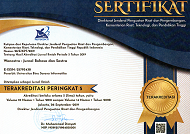Interpersonal Function on Tour Commentaries: A Modality Study
Abstract
Functioned as a social medium, tour commentaries are used by tour guides to interact and communicate with tourists, especially in explaining activities, locations, cultures, and knowledge regarding the place they are visiting. These commentaries bring interpersonal function that is realized through the use of modality. This current study, therefore, aims to (1) identify the use of modalities that bear the interpersonal function found in students’ tour commentaries and (2) describe the meaning of the modalities used. This study employed descriptive qualitative and text analysis methods using Halliday’s theory of modality. The data, 57 utterances containing modality, were obtained from tour commentaries of Tour and Travel Business Study Program’s students of Politeknik Negeri Bandung. This study reveals the use of both modalization, to show ’probability’ and ’usuality’, and modulation, to show ’obligation’ and ’inclination’, on students’ tour commentaries. The ’probability’ and ’obligation’ functions are most discovered. The results can be beneficial academically and practically. They can give insight into how tour guides apply modality in their tour commentaries.
Keywords: modality, modalization, modulation, tour commentaries
Full Text:
PDFReferences
Chen, D., & Shuo, Z. (2018). Analysis of Interpersonal Function in Speech—A Case Study in Obama’s WHCD Address. International Journal of Liberal Arts and Social Science, 6(8), 31–40. https://ijlass.org/data/frontImages/articles/Vol.6No.8/4.31-40.pdf
Darong, H. C. (2021). Interpersonal Function of Joe Biden’s Victory Speech (Systemic Functional Linguistics View). Journal of Education Research and Evaluation, 5(1), 57. https://doi.org/10.23887/jere.v5i1.31420
Eggins, S. (2004). An Introduction to Systemic Functional Linguistics 2nd Edition (2nd ed.). Continuum.
Fan, M., & Bao, C. (2019). Interpersonal Function Analysis of Discourse from the Perspective of Critical Discourse Analysis. 179(Ieesasm 2017), 218–223. https://doi.org/10.2991/ieesasm-17.2018.45
Feng, H., & Liu, Y. (2010). Analysis of Interpersonal Meaning in Public Speeches—A Case Study of Obama’s Speech. Journal of Language Teaching and Research, 1(6), 825–829. https://doi.org/10.4304/jltr.1.6.825-829
Fowler, R. (2013). Language in the news: Discourse and ideology in the press. In Language in the News: Discourse and Ideology in the Press. https://doi.org/10.4324/9781315002057
Gao, Q. (2012). Interpersonal functions of epistemic modality in Academic English Writing. Chinese J. Appl. Linguist. https://search.proquest.com/openview/b2c36bdfbca9750ac44dc839e206d541/1?pq-origsite=gscholar&cbl=2031357
Gerot, L., & Wignell, P. (1995). Making Sense of Functional Grammar: An Introductory Workbook. Gerd Stabler.
Halliday, M. A. K., & Matthiessen, C. M. I. M. (2013). Halliday’s introduction to functional grammar: Fourth edition. In Halliday’s Introduction to Functional Grammar: Fourth Edition. https://doi.org/10.4324/9780203431269
HjRay. (2019). Tour Commentary Delivery. https://geotrainingstudio.com/2019/08/13/cu4-tour-commentary-delivery/
Määttä, S. K., Puumala, E., & Ylikomi, R. (2021). Linguistic, psychological and epistemic vulnerability in asylum procedures: An interdisciplinary approach. Discourse Studies, 23(1), 46–66. https://doi.org/10.1177/1461445620942909
Mair, C., & Fairclough, N. (1997). Critical Discourse Analysis: The Critical Analysis of Language. In Language (Vol. 73, Issue 1). https://doi.org/10.2307/416612
Ngongo, M., & Naniana Benu. (2020). Interpersonal and Ideational Metaphors in the Writing of Thesis Texts of Undergraduate Students of English Study Program: A Systemic Functional Linguistic Approach. RETORIKA: Jurnal Ilmu Bahasa, 6(2), 113–120. https://doi.org/10.22225/jr.6.2.2320.113-120
Olola, P. (2019). The Tour Commentary. https://www.slideshare.net/pauliuslaiminga/the-tour-commentary
Ping, K., & Lingling, L. (2017). Application of Interpersonal Meaning in Hillary’s and Trump’s Election Speeches. Advances in Language and Literary Studies, 8(6), 28. https://doi.org/10.7575/aiac.alls.v.8n.6p.28
Rui, Z., & Jingxia, L. (2018). The Study on the Interpersonal Meanings of Modality in Micro-blogging English News Discourse by the case of “Donald Trump’s Muslim Entry Ban.” Advances in Language and Literary Studies, 9(2), 110. https://doi.org/10.7575/aiac.alls.v.9n.2p.110
Travelbudee.com. (2017). Component of a Good Commnetary. http://blog.travelbuddee.com/components-good-tour-commentary/
Yang, X., & Gao, W. (2020). A Contrastive Analysis of Interpersonal Function of Public Service Advertising in English and Chinese. Sino-US English Teaching, 17(3), 99–105. https://doi.org/10.17265/1539-8072/2020.03.004
DOI: https://doi.org/10.31294/w.v13i2.11224
Copyright (c) 2021 Krisna Yudha Bakhti, Zewitra Zewitra

This work is licensed under a Creative Commons Attribution-ShareAlike 4.0 International License.
Index by:
Published by Department of Research and Community Service (LPPM) Universitas Bina Sarana Informatika by supported Relawan Jurnal Indonesia
Jl. Kramat Raya No.98, Kwitang, Kec. Senen, Jakarta Pusat, DKI Jakarta 10450

This work is licensed under a Creative Commons Attribution-ShareAlike 4.0 International License






